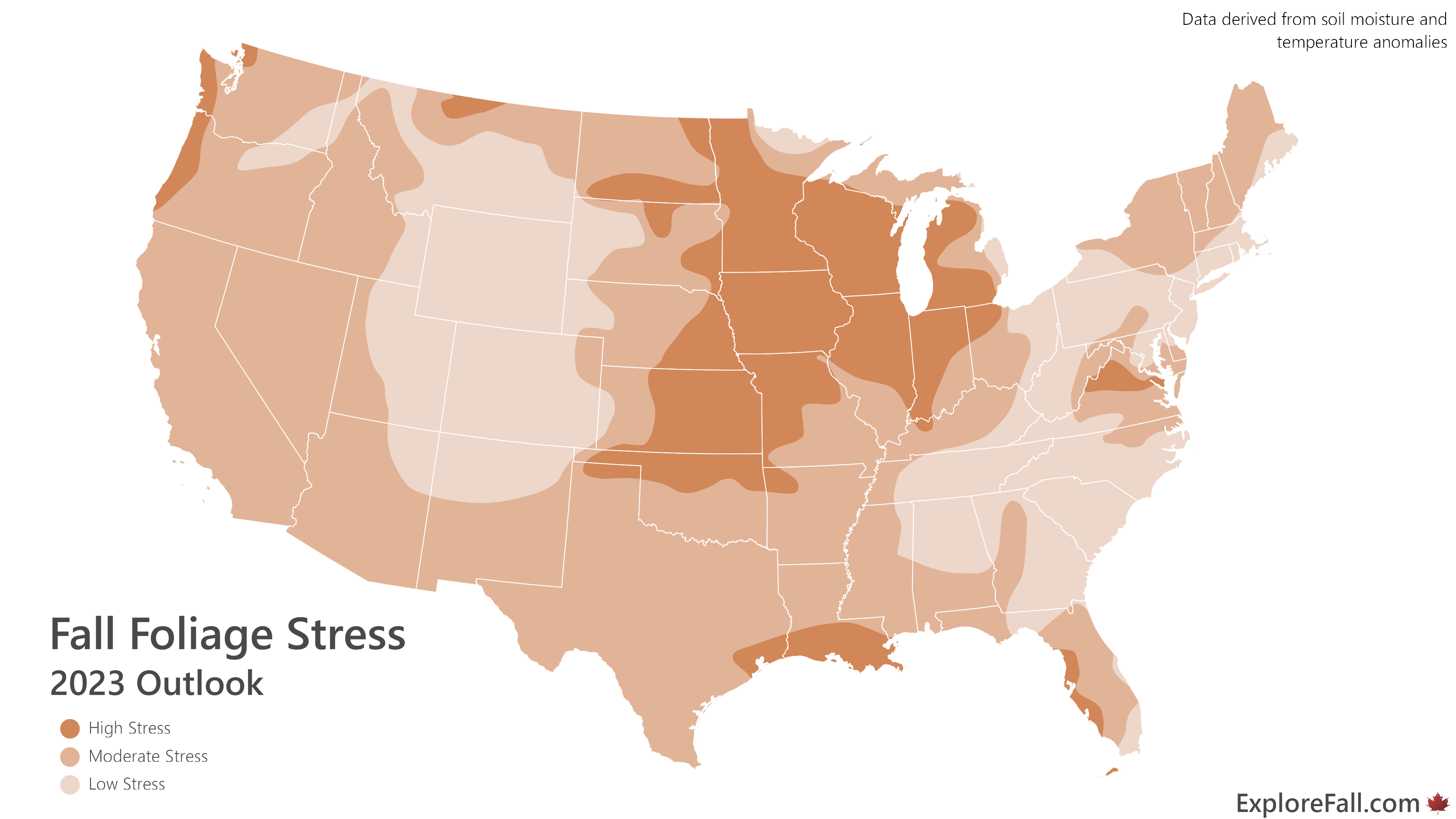
You may have noticed some trees turning color already. What exactly causes these early colors, and how do they affect color quality later in the season? We answer these questions and highlight areas where fall foliage timing and vibrance is most likely to be abnormal in this year's Fall Foliage Stress Outlook. Read below to learn more about the weather's impact on fall color and why you should always check if trees are stressed before planning your fall trip!
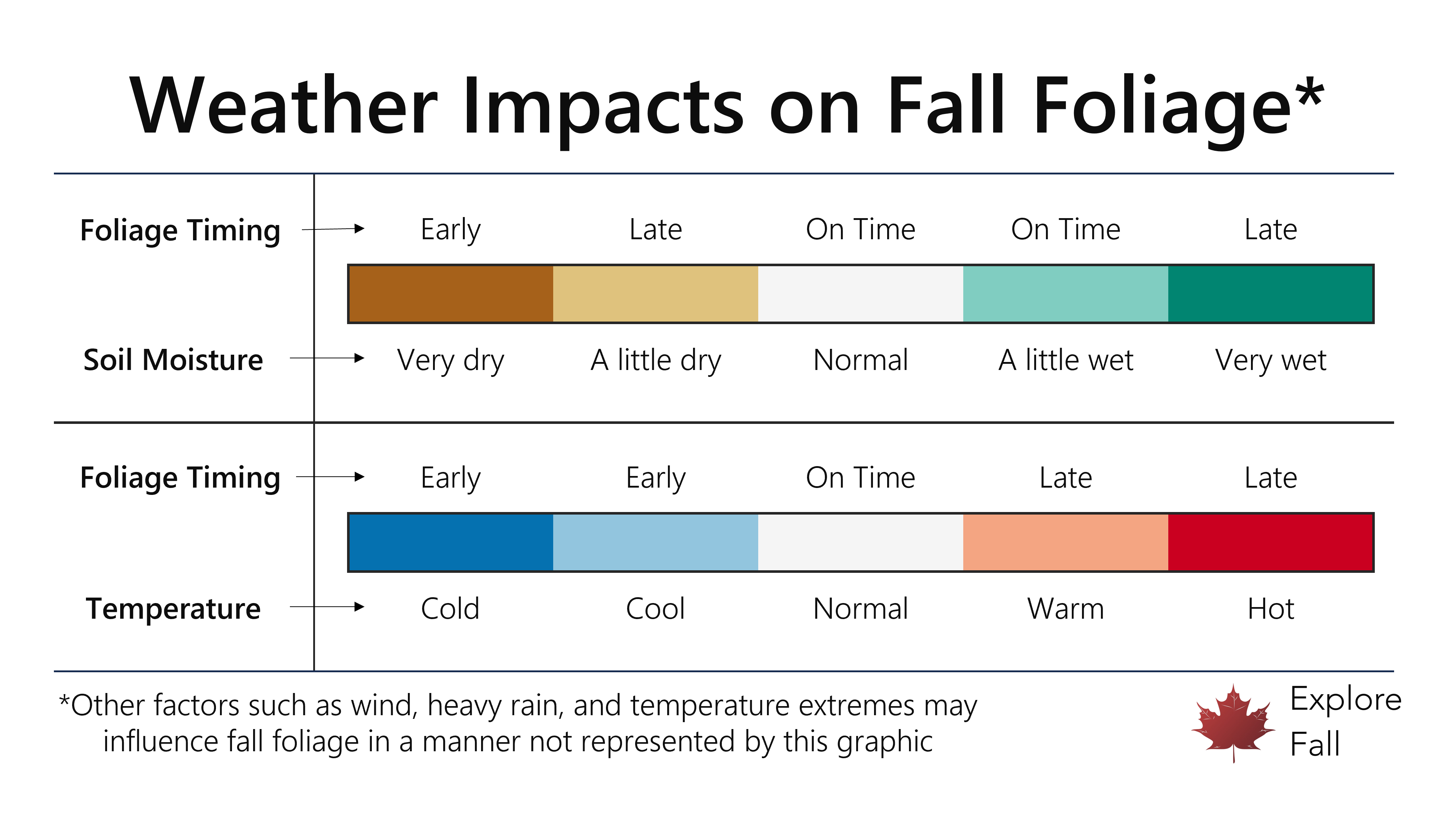
A dry summer without sufficient rainfall often results in dry soils in the fall. Drought has varying impacts on fall foliage, and it can be particularly difficult to quanitify exactly how it will affect the timing of peak color. Drought also impacts the quality of the fall foliage, resulting in muted colors more often than not. Highly stressed trees will lose their leaves early, while moderately stressed trees may hold on to their leaves for longer than normal. In some extreme cases of drought, leaves can forgo fall color entirely, changing straight from green to brown.
In contrast, heavy rainfall in the summer can lead to saturated soils in the fall. Wet soil conditions typically result in delayed fall colors on the order of days to a couple of weeks. Trees need a certain amount of good stress in fall for their leaves to change; however, if soils are too wet, they may not experience that stress until much later in the season. The quality of the colors could be better, but the later colors leave the fall foliage vulnerable to late autumn windstorms.
Temperature also plays an important, albeit simpler, role in the timing and quality of fall colors. Early-season cold will change the colors ahead of schedule, while heat late into the fall months will delay the colors, and often make the colors less vibrant. The best recipe for vibrant colors is an early cold snap followed by cool nights. In the absense of drought or extreme rainfall, fall foliage displays are bright and may maintain their peak color for upwards of two weeks.
At Explore Fall, we offer a region-by-region breakdown of how these weather conditions are trending, and how they may impact the colors in your state. Here is our regional outlook going into the 2023 fall foliage season.
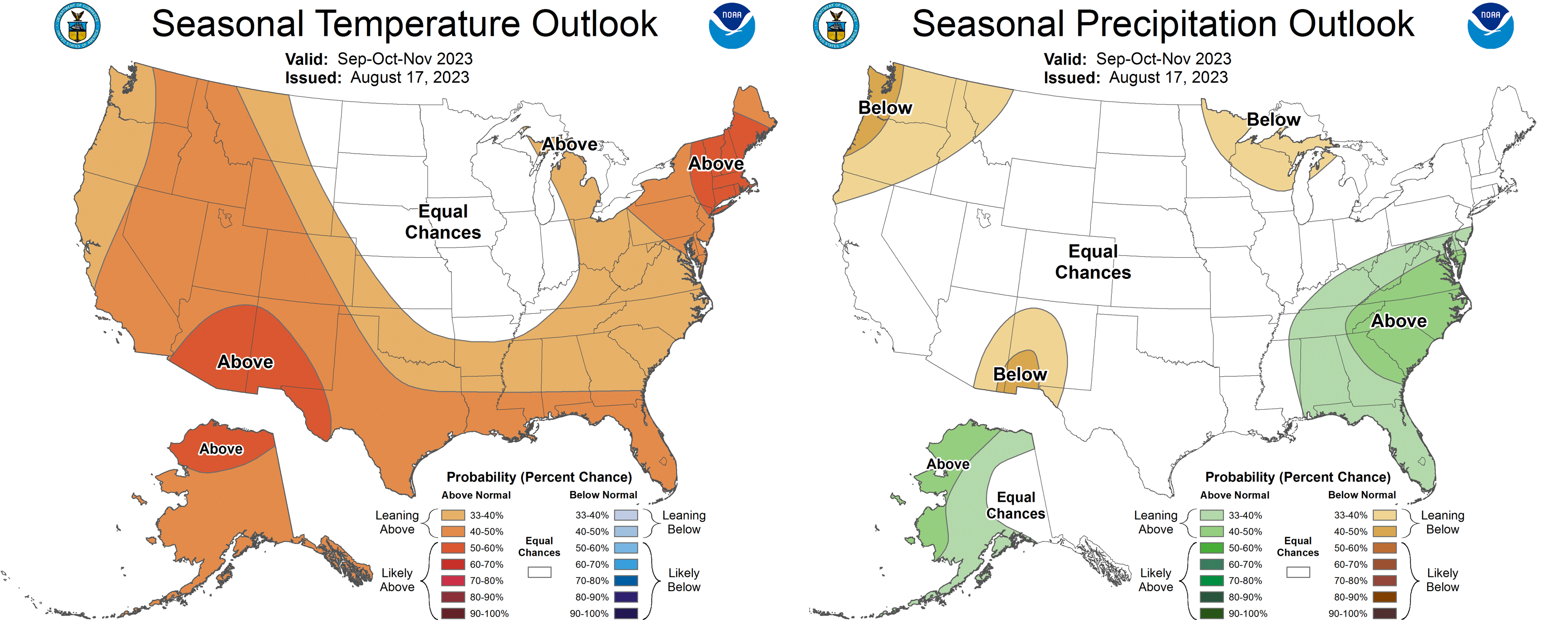
The Climate Prediction Center (CPC) is predicting above normal temperatures in the fall months for much of the United States, likely resulting in regionally delayed fall foliage. These conditions will have the greatest impact in regions that are simultaneously experiencing anomalously wet soil conditions. Both of these factors contribute to delayed color by reducing the usual stress that a tree experiences in fall. It seems backwards to think that reduced stress on a tree can result in increased stress on its fall foliage, but this is exactly what happens when warm and wet conditions trick a tree into believing that it is still in the midst of growing season.
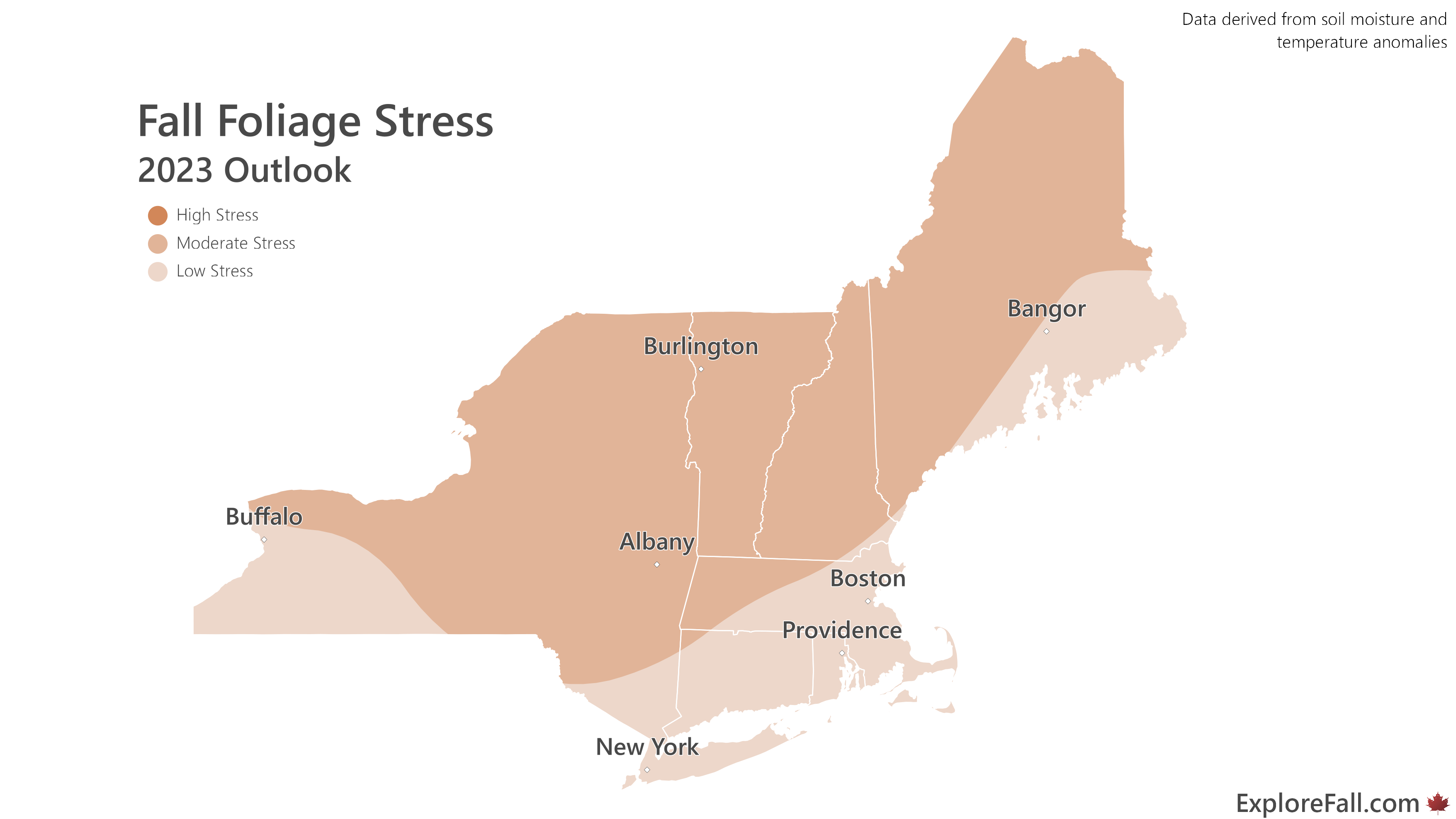
The Northeast has just concluded a very wet summer and is now staring down the barrel of a warm fall, per the latest CPC outlook. We expect these factors to contribute to delayed fall foliage throughout the region; however, we don’t see much cause for concern in the way of significantly muted colors. It won’t be the brightest season on record, but we think travelers visiting the Northeast will still be treated to a great show.
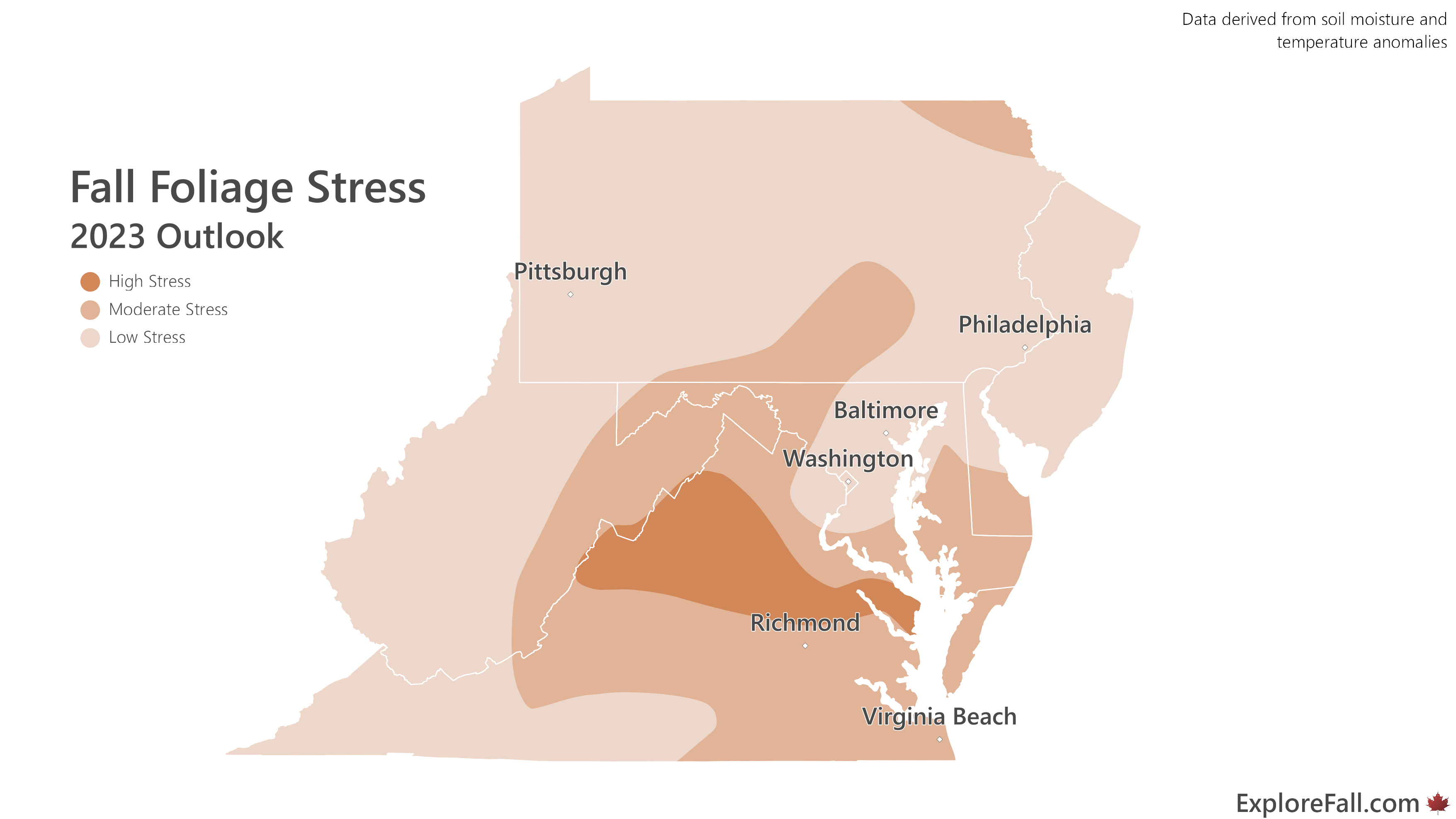
We are growing increasingly concerned about this year's fall foliage in portions of the Mid-Atlantic. Northern Virginia is currently experiencing a severe drought which can cause premature leaf drop and muted fall colors. Dry conditions are widespread into West Virginia, Virginia, Maryland, and Southern Pennsylvania.
In addition, Shenandoah National Park (a regional favorite among leaf-peepers) suffered significant tree damage from the invasive Gypsy Moth earlier this year. Most trees survived the onslaught; however, the defoliation of the high elevations will certainly have a negative impact on this year's fall foliage.
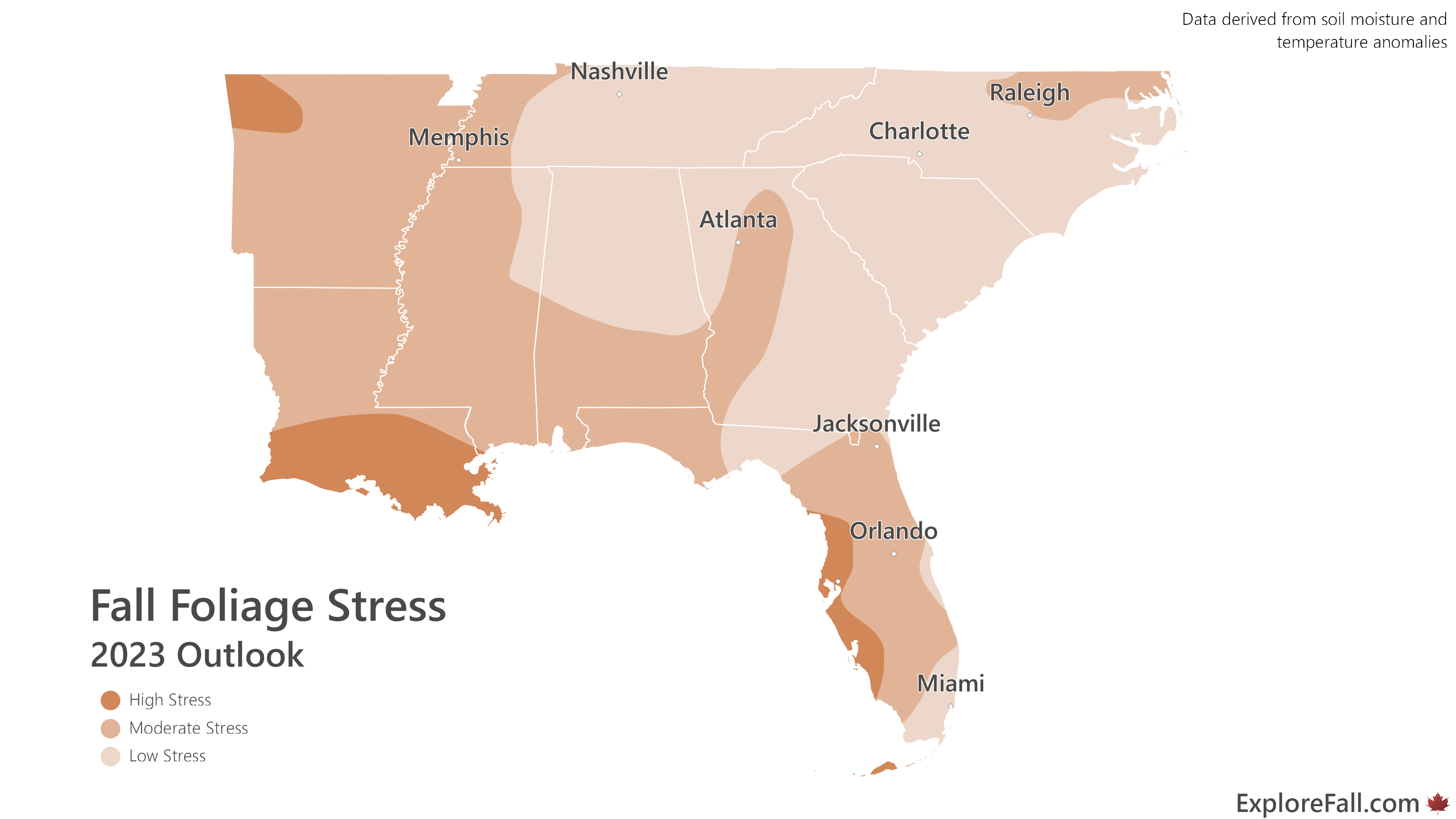
In the Southeast, above average temperatures are less likely than in the Northeast, but the above average precipitation outlook further complicates matters. Wet soils can delay the usual fall stress that a tree experiences, causing it to hold on to its leaves for longer than usual. Barring any significant September/early October heat waves, we expect a healthy, albeit delayed, fall foliage season throughout the Southeast.
It should be noted that despite meteorological data suggesting low stress in the Southern Appalachians, we have received a few stressed tree reports. We will continue to monitor this situation and assess whether any negative impacts will be felt throughout the region.
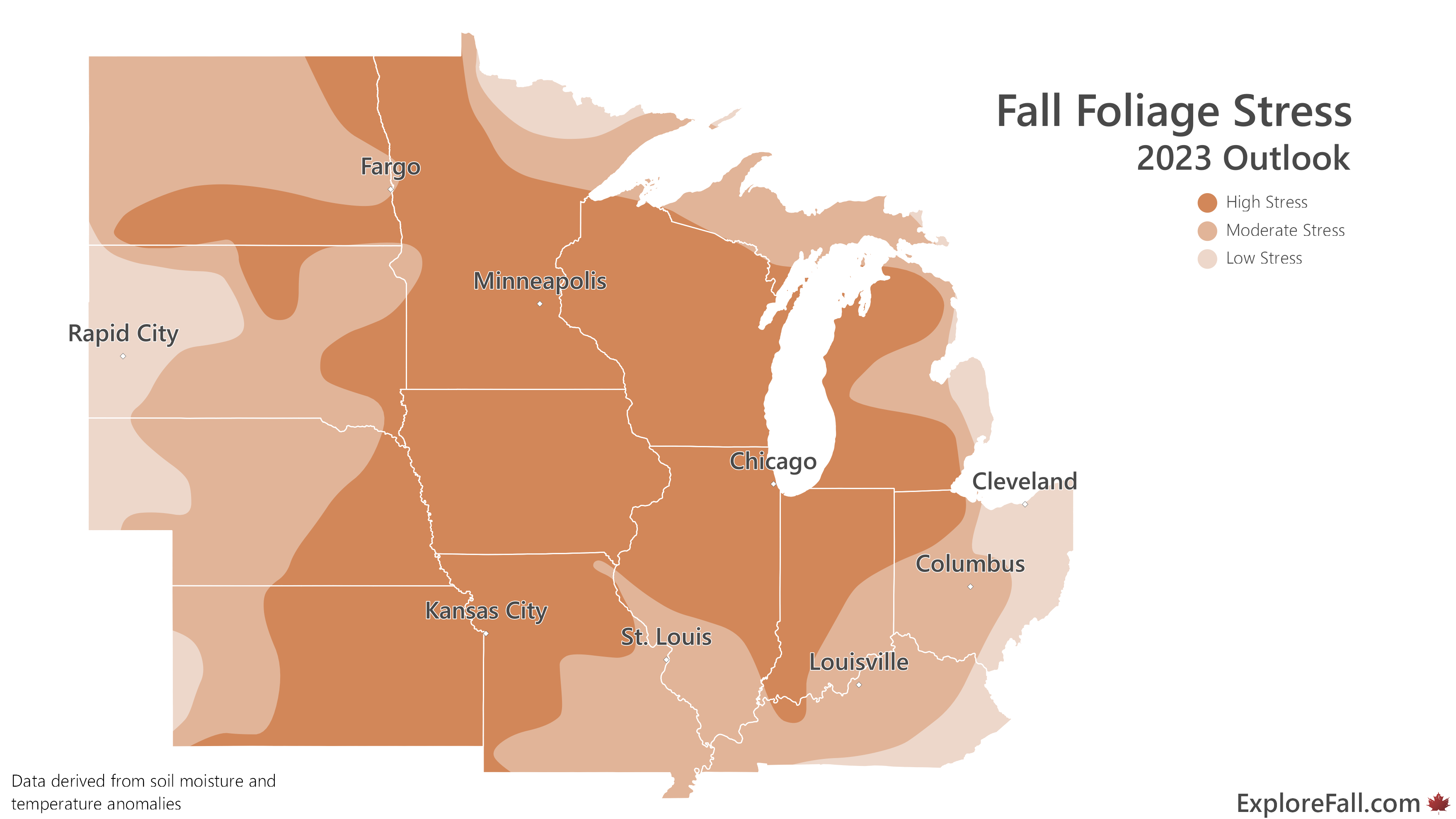
A major drought is ongoing throughout the Midwest, causing widespread stress in the foliage. We are very concerned about this region and expect early leaf-drop in September. Trees will limit nutrients to their leaves in an attempt to conserve water, causing the leaves to wither and turn much earlier than usual. We have already received a number of fall foliage reports from this region, all of which have been stress color and not true fall color.
The CPC predicts drier than normal conditions throughout the northern Midwest, so we do not expect this foliage to make a recovery by the time peak normally occurs in early to mid October. Fall color will still happen throughout the region; however, one can expect muted colors and highly variable timing. The only exception to this appears to be in Michigan’s Upper Peninsula and northeastern Minnesota, where lower stress should couple with near-normal temperatures to produce a beautiful fall foliage display!
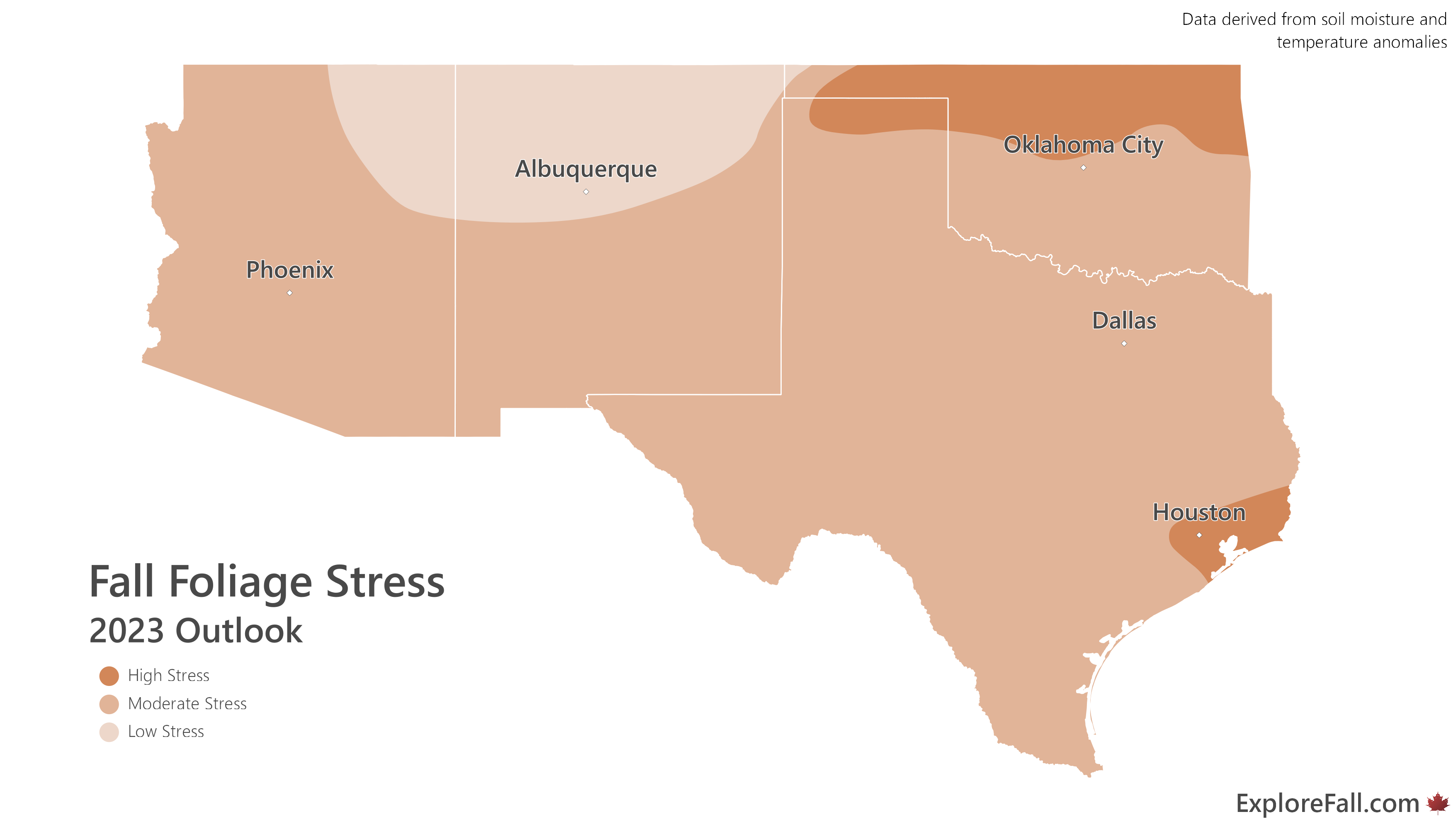
Record heat plagued the Southwest throughout Summer 2023, resulting in stressed trees for much of the region. In addition, drier than normal conditions prevail throughout northern Oklahoma and eastern Texas. The combination of anomalous warmth and drought can be challenging to forecast, as it may result in early, on-time, or even late fall foliage. Any travelers with a vested interest in this region should closely monitor real-time reports.
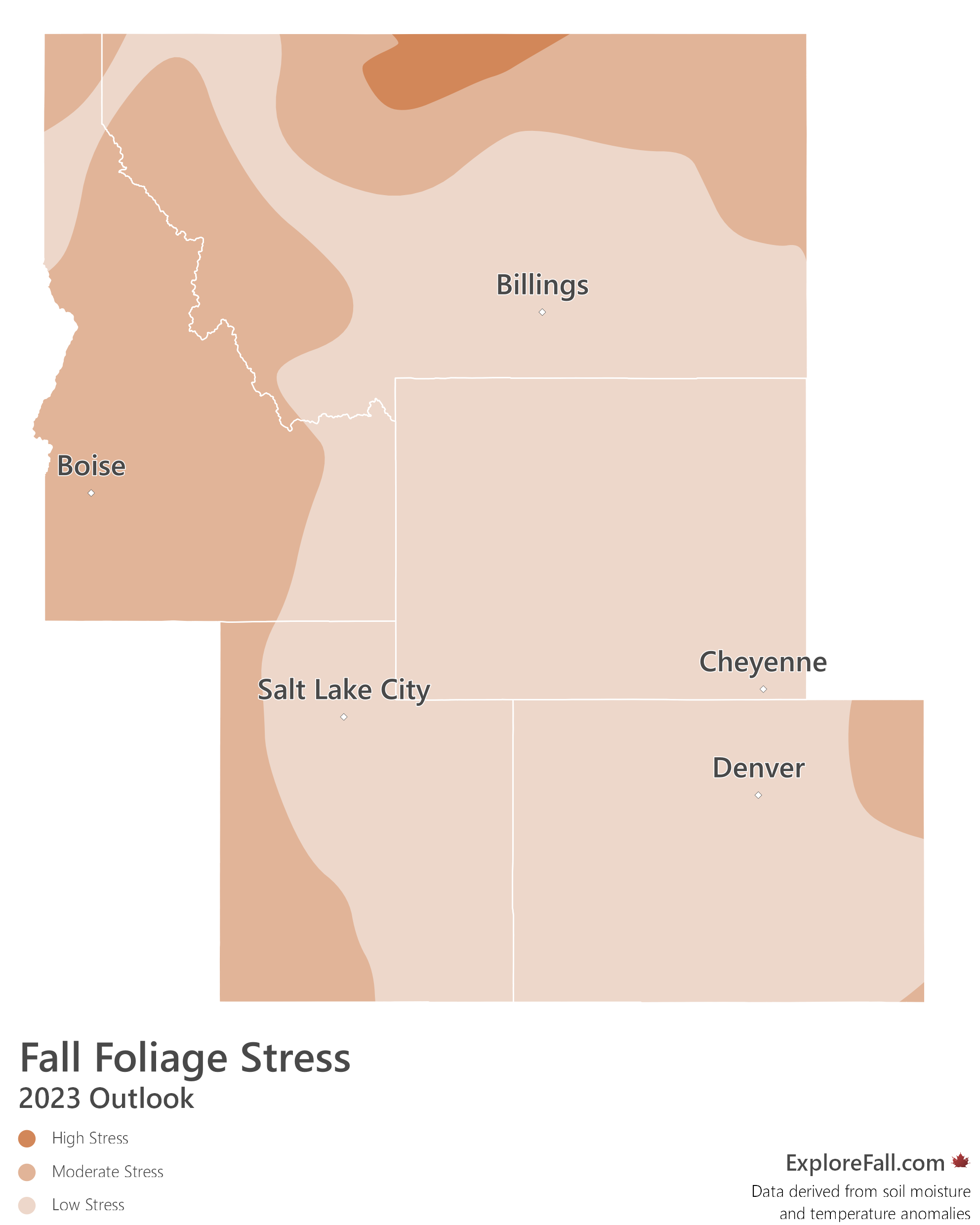
Following a primarily wet and cool summer, the Rockies are well positioned for a brilliant and on-time fall foliage season. Soil moisture anomalies have settled in recent weeks throughout most of the region, with the exception of wet conditions in the western periphery and dry conditions in northern Montana.
For the stressed, wet areas, we expect slightly delayed fall foliage, though the vibrance should not be affected whatsoever. Further north in Montana, the ongoing drought will likely zap a lot of color from the tree, resulting in a muted peak.
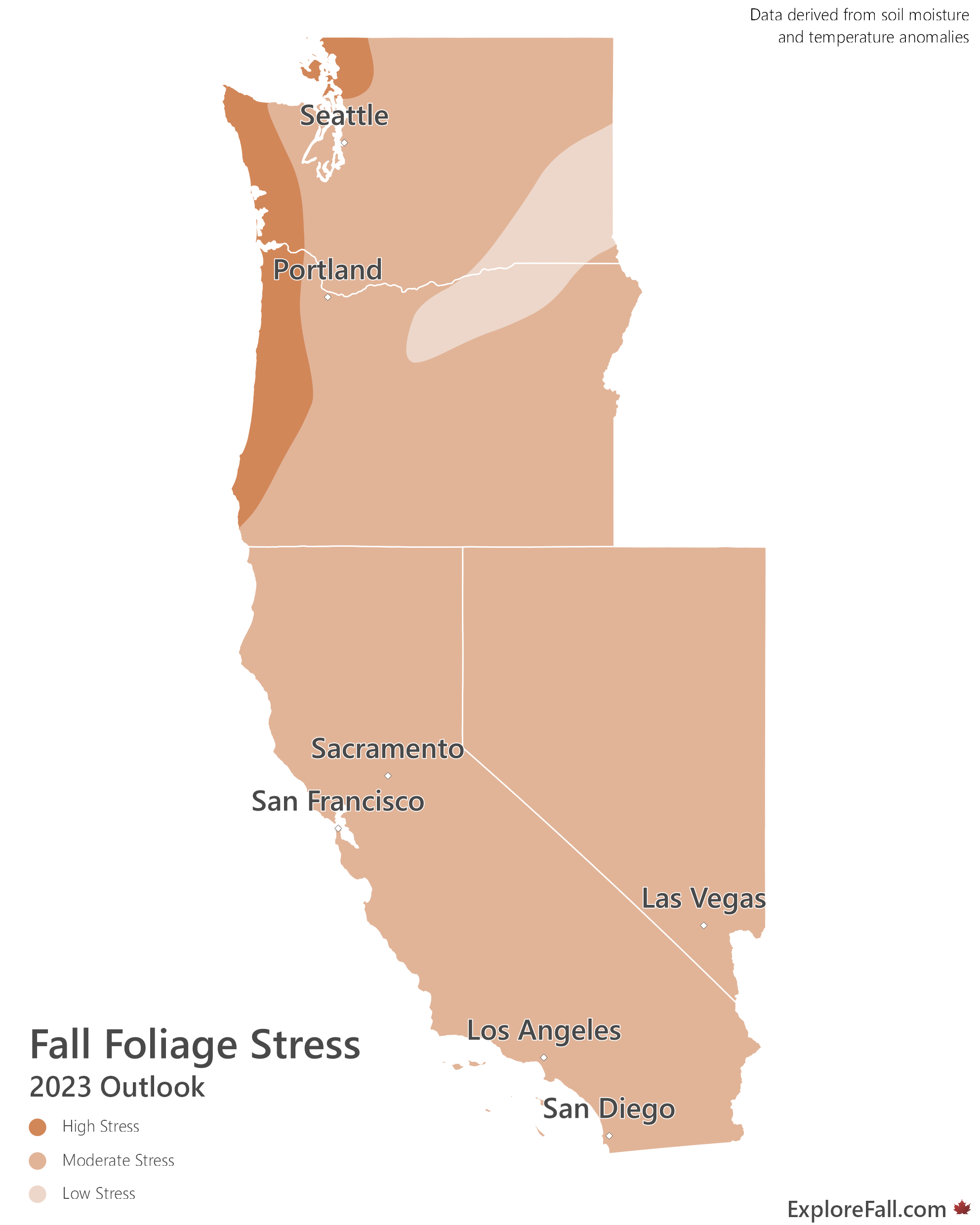
Following record setting rainfall in Winter 2022-23, fall foliage in California is well situated to be healthy and vibrant. Despite this, we have placed it under moderate stress due to the highly anomalous rains that recently fell during Tropical Storm Hilary. Wet soil conditions may result in slightly delayed color, though this should not have any impact on the overall brilliance of this year’s display.
Unlike California, Washington and Oregon are in the midst of a long term drought. The severity of this drought varies throughout the region and so will its impacts on fall foliage. Where soil moisture is much below average, we expect muted colors and early leaf-drop. This includes the coastal areas and may even bleed into Portland and Seattle. Further east, minor drought conditions may simply delay fall color by five days or so.
Ultimately, the weather that occurs in September and October has a greater impact on fall foliage than the antecedent summer conditions. It is important to note that fall foliage outlooks are only as accurate as the weather is fair in the fall months, and extreme conditions can radically alter the timing and brilliance of fall foliage. Take all factors into consideration when making your fall travel plans, and be sure to let us know what you’re seeing in your backyard!
For the latest updates and forecasts, be sure to visit our 2023 Fall Foliage Map. We don't claim to be able to predict the exact timing of peak color two months in advance, but we can guarantee that our ten-day fall foliage forecasts are more accurate than any other source on the Internet. Don't believe us? Go check out our Fall Foliage Map Archive and compare your old photos to the progression on our maps. You won't be disappointed.